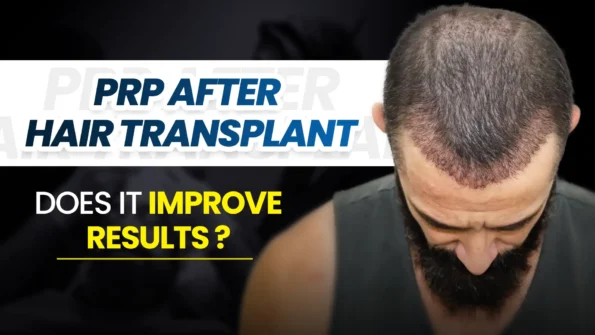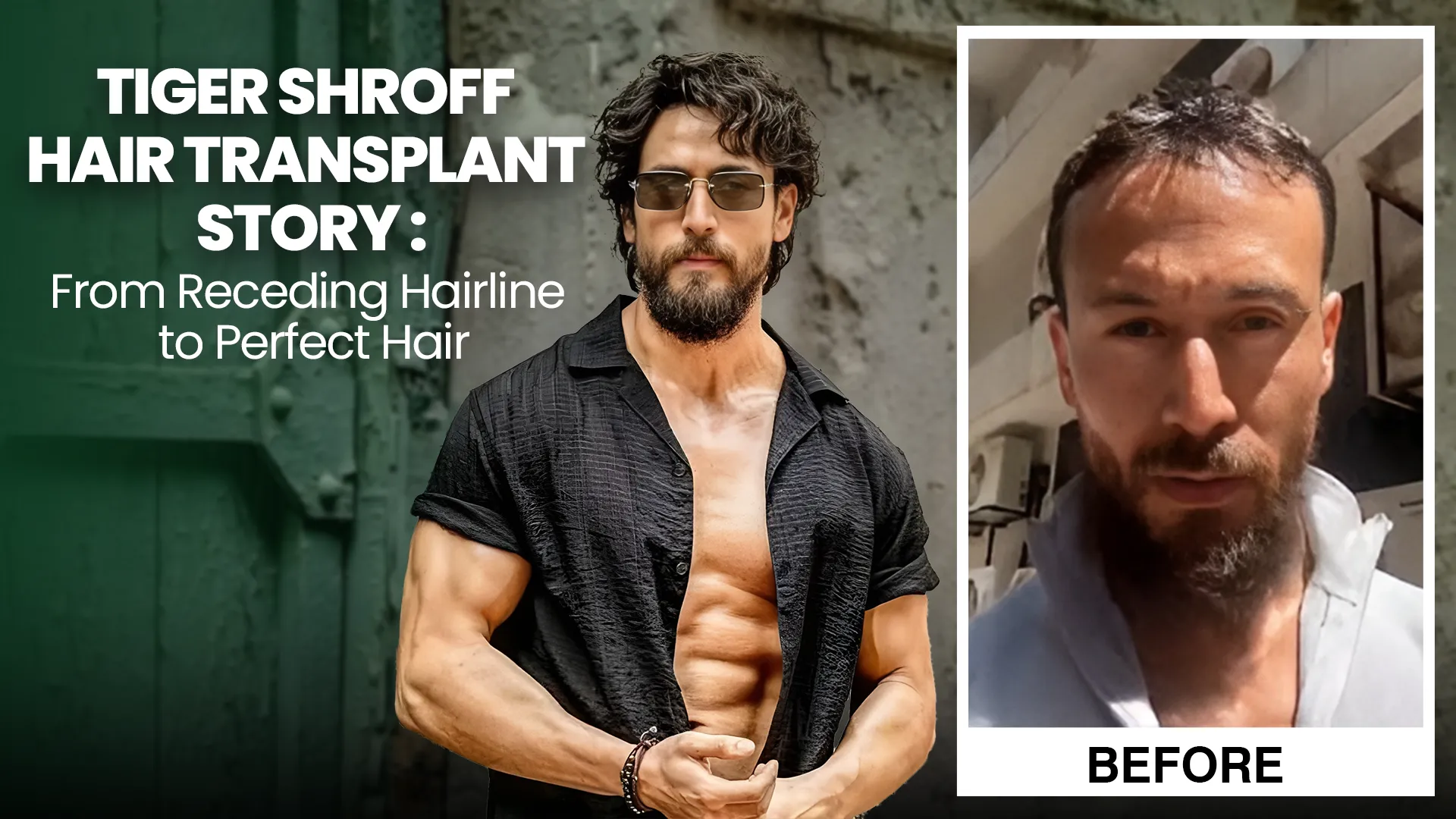You’ve done it. After careful consideration, you’ve invested in a hair transplant, and you’re on the road to a fuller, more confident you. But the journey doesn’t end when you leave the clinic. Your surgeon has likely mentioned a follow-up treatment: PRP, or Platelet-Rich Plasma therapy.
It’s a term you hear everywhere now, but what exactly is it? Is PRP necessary after a hair transplant? When should you start, how many sessions will you need, and what benefits can you realistically expect?
If you’re wondering whether you should consider PRP after hair transplant, this blog will guide you through everything you need to know.
What is PRP and How Does It Work?
PRP, short for Platelet-Rich Plasma, is a therapy that uses your own blood to stimulate healing and hair regrowth. The process is simple:
- A small amount of blood is drawn from your arm.
- The blood is placed in a centrifuge, which spins and separates the components.
- The platelet-rich plasma, which is concentrated with growth factors, is extracted.
- This PRP is then injected into your scalp in thinning or transplanted areas.
Why is PRP effective? Because platelets are rich in growth factors such as PDGF, VEGF, and TGF, which:
- Stimulate hair follicle activity.
- Improve blood circulation in the scalp.
- Boost collagen production and healing.
- Keep hair follicles in the growth phase for longer.
The whole treatment takes less than 30 minutes, involves no downtime, and can significantly improve the health of transplanted and existing hair.
Does PRP Improve Hair Transplant Results?
This is the biggest question patients ask: Does PRP actually improve the outcome of a hair transplant?
The evidence we have so far is very encouraging. Clinical studies suggest that:
- PRP after transplant can increase graft survival rates, leading to denser and thicker hair.
- Patients who had PRP after their transplant showed faster hair growth and reduced shedding compared to those who didn’t.
- PRP can also minimize scarring from FUT procedures by accelerating tissue healing.
In fact, some studies have shown a 15% higher follicle density per cm² when PRP was used as part of the hair transplant process. Another study found that men who received 3 PRP sessions post-transplant had significantly more hair density and shaft thickness after six months compared to placebo.
So while more large-scale studies are needed, the early results strongly suggest that PRP enhances hair transplant outcomes.
Benefits of PRP After a Hair Transplant
Here are the main reasons why PRP is considered a valuable add-on after hair restoration surgery:
1. Faster Healing and Recovery
The growth factors in PRP promote tissue repair and new cell formation. This means less redness, swelling, and faster recovery post-transplant.
2. Higher Graft Survival Rate
PRP improves blood supply and nutrients to transplanted follicles, increasing their chances of survival and reducing graft loss.
3. Reduced Shedding Phase
Hair transplants often trigger shock loss, a temporary shedding stage. PRP can shorten this dormant phase and help follicles return to the growth cycle quicker.
4. Improved Density, Thickness, and Hair Quality
PRP strengthens both new grafts and existing hair, resulting in thicker strands, increased density, and healthier scalp condition.
5. Helps with Scarring and Complex Cases
For patients with scarring alopecia or previous burns, PRP enhances tissue healing and makes transplants more successful. It can also reduce visible scarring from FUT procedures.
When Should You Get PRP After a Hair Transplant?
Timing matters. Most surgeons recommend starting PRP about 3–4 weeks after your hair transplant, once the scalp has healed from surgery.
A typical course looks like this:
- Initial sessions: 3 treatments spaced 4–6 weeks apart.
- Maintenance sessions: Every 6–12 months to preserve long-term results.
In some studies, patients began PRP as early as 7 days after transplant, but waiting a few weeks is generally safer to avoid stressing healing tissues.
How Many PRP Sessions Do You Need?
The number of sessions depends on your level of hair loss and your doctor’s advice. However, most patients see the best results with:
- 3 sessions in the first 3 months (spaced 4–6 weeks apart).
- Follow-up maintenance once or twice per year.
Consistency is key. A single session can help, but results are much more noticeable after multiple treatments.
Risks and Side Effects of PRP After Hair Transplant
PRP is considered very safe because it uses your own blood. Still, there are some minor side effects that can occur:
- Temporary redness, swelling, or soreness at injection site.
- Mild bruising or headache.
- Rarely, infection if not performed under sterile conditions.
You may not be eligible for PRP if you:
- Have a platelet disorder or critically low platelet count.
- Are on strong blood thinners or corticosteroids.
- Have an active scalp infection.
Always consult your doctor before beginning PRP sessions.
PRP vs. Minoxidil After Hair Transplant
Another common question is: Should I use PRP or Minoxidil after a hair transplant?
- Minoxidil: A topical medication proven to maintain existing hair and slow further hair loss.
- PRP: A natural treatment that boosts healing, graft survival, and new hair growth.
A 2016 study on 220 men with male pattern baldness found that PRP had better results than Minoxidil in terms of hair density and thickness. Patients also reported higher satisfaction with PRP.
That said, many doctors recommend combining PRP with Minoxidil or Finasteride for the best outcome, as they work in different ways.
Cost of PRP After Hair Transplant
The cost of PRP varies depending on your location, clinic, and number of sessions needed.
- UK & US average cost per session: £200–£500 ($250–$600).
- India average cost per session: Rs.10,000-12,000
Some clinics offer packages when combining PRP with a hair transplant, which may lower overall costs.
Alternatives to PRP After Hair Transplant
While PRP is one of the best post-transplant boosters, it’s not the only option. Other effective treatments include:
- Minoxidil – daily topical solution or foam.
- Finasteride / Dutasteride – oral medications to stop further hair loss.
- Low-Level Laser Therapy (LLLT) – devices that stimulate scalp blood flow.
- Derma rolling – improves absorption of topical solutions.
Often, doctors recommend combining PRP with one or more of these treatments for maximum effectiveness.
Key Takeaways
- PRP after hair transplant can significantly improve results by accelerating healing, improving graft survival, and boosting density.
- The first session is typically done 3–4 weeks after surgery, with 3 sessions in the first few months recommended.
- Side effects are minimal, but PRP isn’t suitable for everyone.
- PRP may be more effective than Minoxidil alone, but combining both offers the best outcome.
- The cost ranges from Rs. 10,000-12,000 per session.
- Alternatives like Minoxidil, Finasteride, and laser therapy can also be considered alongside PRP.
Conclusion
If you’ve undergone a hair transplant and want to maximize your results, PRP is one of the most effective add-on therapies available today. It not only supports faster healing but also ensures stronger, denser, and healthier hair growth in the long run.
Every patient is different, so the best approach is to consult your surgeon or trichologist to see if PRP after hair transplant is right for you. Combining the science of surgery with the healing power of your own blood may just be the key to restoring not only your hair — but also your confidence.
Take the First Step Towards Fuller, Healthier Hair!
At Hairfree & Hairgrow Clinic, we specialize in advanced PRP therapy and hair transplant solutions designed to give you natural, long-lasting results. With over a decade of expertise and thousands of successful cases, our team of specialists ensures you get the right treatment for your unique needs.
Book your free consultation today and discover how PRP after a hair transplant can transform your results.
Visit us at Hairfree & Hairgrow Clinic or call us at +91 72728 32222 to schedule your appointment.
Because your confidence deserves the best care.
FAQs About PRP After Hair Transplant
1. Is PRP necessary after a hair transplant?
PRP is not mandatory, but it is highly recommended. It accelerates healing, improves graft survival, and promotes healthier, thicker hair growth, leading to better results.
2. How soon can I get PRP after a hair transplant?
Most doctors suggest starting PRP sessions 3–4 weeks after the hair transplant surgery. This allows initial healing before boosting growth with PRP.
3. How many PRP sessions are required after a hair transplant?
On average, patients need 3–6 PRP sessions, spaced 4–6 weeks apart. However, the exact number depends on the doctor’s advice and individual hair condition.
4. Are there any side effects of PRP after a hair transplant?
PRP is generally safe since it uses your own blood. Some patients may experience mild redness, swelling, or soreness at the injection site, but these effects subside within 24–48 hours.
5. Does PRP guarantee 100% results after a hair transplant?
No treatment can guarantee 100% results, but PRP significantly improves graft survival and hair density. It maximizes the chances of achieving fuller, natural-looking results after a transplant.
Written By
MBBS, DNB
Dr. Preeti Kantwala explains that PRP after hair transplant helps in faster healing, strengthens new grafts, and improves hair growth results. With years of experience in advanced hair restoration, she provides safe and effective PRP treatments to ensure long-lasting and natural-looking outcomes.



